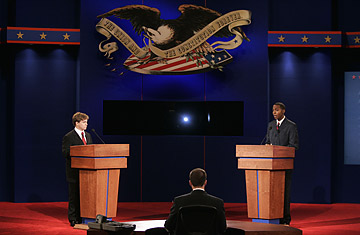
Two students fill in for John McCain and Barack Obama during a technical walk through for the first presidential campaign debate between the Democratic and Republican presidential nominees at the University of Mississippi in Oxford, Mississippi.
Barack Obama and John McCain have never debated each other, but both may whiff some déjà vu when they hold their first showdown tonight in Oxford, Miss. — they've likely spent days sparring with their opponent's spitting image.
Away from the lights of TV news cameras and the keyboards of bloggers, stand-ins have been holding secretive mock debates with the candidates to help them gear up for the real thing.
Since 1976, stand-ins — often friendly politicians or close outside advisers — have helped prepare candidates by mimicking every facet of an opponent, offering the same arguments, applause lines and even jokes. Those who've done it in the past say it's no easy task.
"It was probably one of the most intense things I've ever done," says New Hampshire Sen. Judd Gregg, who played Al Gore (twice) and John Kerry for Republican candidates between 1996 and 2004. He likened the job to cramming for the bar exam. "The key is to totally absorb yourself in the person you're supposed to present."
Washington lawyer and veteran Democratic debate stand-in Greg Craig was tapped by the Obama campaign to play John McCain, while Michigan governor Jennifer Granholm will channel Sarah Palin in sessions with Joe Biden. The McCain campaign won't discuss the roles on their side.
A good stand-in needs to know a lot more than what words an opponent is likely to use. Another Republican stand-in playing Gore in 2000, former Ohio Rep. Rob Portman, noticed that in a previous debate Gore had left his stool and approached Bill Bradley during an answer — "seeming to try a little physical intimidation to rattle him," Portman says.
Portman did the same with Bush during a prep session, so it was little surprise when Gore pulled the same move on Governor Bush during their final debate. Bush gave him a dismissive nod and continued without missing a beat, prompting laughter from the audience and pans for Gore from the pundits. Point for Bush.
Another role for the stand-in, experts say, is to make candidates comfortable going up against rivals — and not just rhetorically. "For Dan Quayle I put on a golf sweater, put a golf tee behind my ear and twirled a putter," says former Ohio Rep. Dennis Eckart, who worked with Democratic Vice Presidential candidates Lloyd Bentsen in 1988 and Gore in 1992. "It broke the tension."
One of Gore's mock debates was set up in a Tennessee barn, Eckart said, including an entire debate hall — podium, TV studio and all. "But it was in rural Tennessee, his home state.... I felt it would make him more comfortable than being in a Hyatt somewhere sleeping in a hotel room."
Others agreed that mock debates are often designed to be exactly like the real thing, with stand-ins even playing moderators. "We debated right at 9 o'clock. Same temperature setting, same distance, same format," says former New York Rep. Tom Downey, who spent four days playing Jack Kemp before Al Gore's Vice Presidential debate in 1996. "I tried to be as good at Jack Kemp as Jack Kemp would be."
Both the Obama and McCain campaigns declined to discuss specific details of their preparation. "It's the sausage-making part of the process," says Alan Schroeder, a Northeastern University journalism professor and author of Presidential Debates: Fifty Years of High-Risk TV. "It's the part of the process the public is not meant to see."
While a good sparring partner can help prepare a smooth retort or well-planned zinger, a bad stand-in can damage a performance.
Before Quayle's infamous 1988 debate with Lloyd Bentsen, stand-in Bob Packwood assured Quayle that Bentsen was a courteous man who wouldn't be rough on the young Senator, Schroeder says.
That may have left Quayle particularly vulnerable to Bentsen's withering retort after Quayle compared himself to John F. Kennedy: "I served with Jack Kennedy. I knew Jack Kennedy. Jack Kennedy was a friend of mine. Senator, you're no Jack Kennedy." Quayle, abashed, had nothing in his arsenal to fire back.
"That's the most famous putdown in debate history," Schroeder says. "There's an example of bad preparation."
